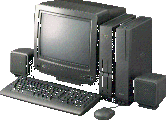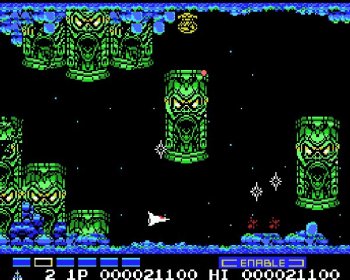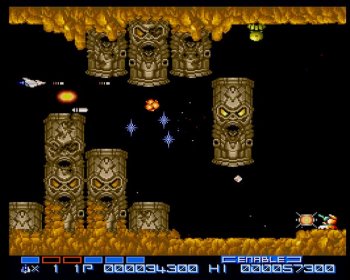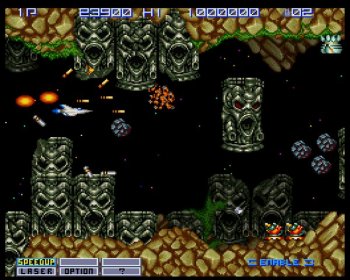





FICHA TECNICA:
Nombre: X68000
Manufacturado: Sharp
Tipo: Home Computer
Origen: Japón
Año: 1987
teclado: Full-stroke keyboard
CPU: MC68000 producido por Hitachi con licencia de Motorola
Motorola MC68000
Velocidad: 10 MHz (ampliable hasta 20 MHz)
COPROCESSOR: Desconocido
RAM: 1 MB (ampliable a 12 MB)
VRAM: 512 KB graphic + 512 KB text
ROM: 1 MB
Modos de Texto: Desconocido
Modos Gráficos: 256 x 240 / 256 x 256 / 512 x 240 / 512 x 256 / 512 x 512 / 640 x 480 / 768 x 512 / 1024 x 1024128 sprites (16 x 16)
Colores: 65535 colores (16 colores in 1024 x 1024 to 65K in 512 x 512)
Sonido: FM Sound (Yamaha 2151 : 2 channels / 8 octaves stereo) + PCM (OKI MSM6258V : 4 bit mono)
I/O Puertos: Joystick(2), Audio IN / OUT, Stereo scope, TV Control, NTSC Video Image I/O, Expansion (2 slots), External FDD, SASI, RS232 , HDD SCSI...
Soporte: 2 x 5.25'' disketeras
OS Human 68K 1.0 + VS
Efectos: Posibilidad de usar transaprencias, rutinas gráficas similares al modo 7 de Super Nintendo...
Periféricos: Built-in power supply unit
...Ahora como me da perrería copio textos que he encontrado por la R_E_D"
![otra sonrisa [jaja]](/images/smilies/nuevos2/otrasonrisa.gif)
--Emulatronia--
"Todos conocemos, o hemos oído hablar, del Atari ST y del Commodore Amiga, los ordenadores que introdujeron los 16 bits en nuestras casas (o en la de otros ;-D). Pero del que seguramente no has ni oído hablar es del X68000, un ordenador nipón de la misma "quinta" del ST y del Amiga, del que se llegaron a vender 120.000 unidades en Japón y sólo allí, porque Sharp se limitó solo y exclusivamente al mercado nipón.
Pero conozcamos la "máquina". Fue un ordenador ideado y comercializado por la compañía japonesa Sharp y fue lanzado al mercado allá por 1985-86, hace ya bastante tiempo.. Por el año, puede dar lugar a dudas sobre sus características técnicas, pero nada más lejos de la realidad, resulta increíble conocer estas características para la época y aún mas ver los juegos y aplicaciones que se programaron para él. El ordenador en sí estaba gobernado por el mismo cerebro que el Amiga y el Atari ST (el 68000), aunque las conversiones de recreativa de las que gozó en algún caso fueron casi perfectas. Recordemos que esa época estaban pegando fuerte en el resto del mundo los ordenadores de 8 bits, con lo que aún impresionan más sus virtudes técnicas.
Tenía su propio y único sistema operativo, como el Amiga y el Atari ST, programado por Hudson, aunque en cuatro versiones: una era el HumanOS, bastante parecida al MS-DOS, otra se asemejaba al TOS de Atari (Human68K), otra versión recuerda a las X-Windows de Unix (KO-Windows) y otra al más puro estilo Workbench de Amiga. Todo, claro está, en perfecto japonés... ;-D
Respecto a su software, el catálogo fue muy amplio: cientos juegos y aplicaciones. Y los juegos no eran precisamente desconocidos. Juegos y recreativas como Gemini Wing, Ghouls and Ghosts, Final Fight, Bubble Bobble, Bomberman, Darius, etc., fueron llevados a los circuitos de esta gran máquina de una manera magistral.
Bueno sí, no hacemos nada más que elogiar las características técnicas, pero todavía no hemos concretado nada sobre ellas. Pues bien, para los entendidos tenemos aquí la relación de las características técnicas de uno de los mejores ordenadores de todos los tiempos (¡ah!, ¡recuerda que estamos en 1985!):
Para el almacenamiento, tenía dos unidades de disco de 5 y cuarto de 1.2 Mb ). El sistema de archivos era compatible con MS-DOS, o sea, que se puede leer su contenido en nuestro PC y con nuestro querido MS-DOS (X-D). También se le podía conectar un disco duro SCSI o SASI (¿alguien me puede decir que es un disco duro SASI?

.
En conclusión, estamos delante de un ordenador bastante desconocido en nuestras tierras con unas características técnicas envidiables y que gozó en su tiempo de un software más que bueno. Nunca es tarde para conocer "engendros" como éstos. Lo que es bueno, lo será siempre, y si no lo crees, bájate el emulador, carga algún juego y ya me contarás."
--einnn--
"Aquí está el primer de una gran familia. Es el sucesor de la familia aguda X1, enviado con un monitor cuadrado único de la pantalla. En vez de usar el Zilog Z80, utiliza un Motorola de gran alcance MC 68000. Esta computadora (y toda su familia) tiene grandes características (mirada en el emulador), él eran más de gran alcance que las otras 68000 computadoras en este tiempo (ST o Amiga 500 de Atari): más colores o más sprites del hardware, movimiento en sentido vertical del hardware, genlocking, perspectiva o playfields (hasta 16). ¡Desafortunadamente, nunca era Japón exterior puesto donde estaba y sigue siendo muy muy popular! ¡Demasiado malo, soy seguro que tendría un gran éxito!! Una gama muy grande de juegos fue desarrollada para el serie X680x0 y las mejores conversiones de la arcada fueron hechas en esta computadora. Funciona debajo de 68K humano, un sistema operativo CONTRA el cual los parecer CP/M 68 o MSDOS y las aplicaciones un interfaz utilizador gráfico llamaron. Note que el desarrollo sigue siendo activo en esa computadora, varia hacia el lado de babor OSes se ha virado en el X68000, el más famosos son Minix y Unix NetBSD y todas las herramientas del GNU y allí está algunos proyectos en el desarrollo: XNeptune (una tarjeta de Ethernet) o Ko-Windows (' NextStep-como ' el ambiente gráfico"
"The X68000 was a super-capable series of computers sold between 1987 and 1993. If you imagine a souped-up ST or Amiga with more power, better software support and a sexy twin-tower mainframe-like design you'd not be far off. One of the very best reasons to own one of these systems is the string of official releases from some of Japan's top codeshops at the time. Konami + Capcom made arcade-perfect ports of their popular games, and Namco + Sega licensed some very talented publishers to do the same. Many of these games are pixel-for-pixel clones of their arcade counterparts. In one test I took an emulated screengrab of Ghouls n Ghosts from the X68000 and from MAME, cut one in half and slid the image over the other - they meshed perfectly. Same resolution, same graphics. In Capcom's Fighters History book they mention the X68000 versions of Street Fighter Dash + Super Street Fighter are "Arcade Perfect." This from the original manufacturer of the arcade game! Many games had bonuses as well, making them perhaps more useful or valuable than the arcade versions. Hi-res intro screens, music + stage select, the ability to pause... Most games as well came in very large deluxe packaging, normal for the Japanese computer industry at the time. No flimsy cardboard here, just quality clamshell cases or plastic boxes with paper sleeves. Konami's releases came in a massive flip-top jewel-case-like box with a cardboard sleeve outside, and loaded with extras. Many games in fact came with free goodies. Postcards, cloth banners, booklets, heavily illustrated manuals, and sometimes extra controlers or adaptors. Pac Land, Crazy Climber, LibbleRabble and Street Fighter all came with extras to make the game more playable at home.
Here then is a gallery of some of the best looking X68000 games, including a bunch of the high-resolution title screens many games would boot up with. Most of these came on one or two 5.25" floppy discs, many had a disc or two just for the introduction. Please enjoy the gallery."
"The Sharp X68000 computer. Virtually unknown in the U.S., it seemed to be quite popular in Japan. Very little info about the X68000 (from this point called the X68K) is available online, yet nuggets of info about it and it's games have surfaced.
Konami of Japan supported the X68K with several translations of their popular games series. A Castlevania game was released for the X68K, called Akumajo Dracula X68000. This game recently got a facelift and rerelease for the Sony PlayStation as Castlevania Chronicles, and was released for the first time in the U.S.
Well, that's great. I'm a huge Castlevania fan, and I was thrilled when Castlevania Chronicles was released here. I was finally able to play one of the lost games in the series.
But what about Gradius (which I'm also huge fan of, as most regular readers know)? It's not very often that Konami would release a Castlevania for a system without doing at least one Gradius game for that same system. With the exceptions of the Sega Genesis/Mega Drive, N64 and Dreamcast (which got no Castlevania games at all), that's been the case for every system or computer that Konami has programmed for... and, as it turns out, Konami of Japan did indeed release a Gradius game for the X68K. They actually released several, according to The Gradius Homeworld - among them Gradius, Gradius II, Gradius III, Salamander and Parodius.
They didn't stop there, though. They released an conversion of the MSX Gradius 2 game, called Nemesis '90 Kai. Unfortunately, information on it is scarce. There are many Gradius sites out there, but few have information on it - and what they do usually have isn't very expansive. Usually Nemesis '90 Kai gets a quick mention, but not much else.
But now, thanks to the Video Game Museum, pictures have surfaced of the elusive Nemesis '90 Kai - and it looks awesome. Unfortunately, the odds of seeing it rereleased for a modern console like Akumajo Dracula X68000 are slim to none... and slim, I believe, just left town. Sucks to be us, huh?
Oh well. Unless Konami decides to release some kind of X68K deluxe pack, or bundle this in with any future Gradius release, the following pictures may be all we ever see of it..."
Una "pequeña" lista de algunos de sus juegos:
R・TYPE
CHACHA
ATOMIC ROBO-KID
AFTER BURNER II
Image Fight
WINGS
WIND BLAST
Scuderia Phantom
AJAX
AERO FIGHTER
Outer Field
X-TYPE
SPRITE
MCHA
FNEW
OVER DRIVE
μproject
OLTEUS II
WINKY
Girst
GAIARM
GAIA FIGHTER II
GAMMMA PLANET
COMPAC
究極TIGER
KANEKO
Galaga'88
Ku2
PANTHER
Ku2FrontRow
PANTHER
Cranked arrow
クレンダツウ侵攻
PROJECT K
GRADIUS
SPS
GRADIUSⅡ -GOFERの野望
Granada
WOLF TEAM
GAME.X
KUGENUMA SOFT
CODE-ZERO
COTTON
COMMAND XRAY
CYBER CORE
PSYCHO HARRIER
CYBER MISSION
SADES
沙羅曼蛇
THUNDER FORCE
Thunder Blade
3段変形メカファジー
XADLAK
C・ON・Z
SEAFIGHTER
SION
SION Ⅱ
SION Ⅳ
SOFT BANK
Shooting Stars
SHOOTDOWN70
Project-K
Silsteel
P PINK.POT
Gemini Wing
SYSTEM SACOM
JASTIS(0)
ASM
Super STAR SHOOTER
SUPER HANG-ON
SCORPIUS
STAR WAR 1991 VER.2
K.Y.A.T.
STAR WARS
MNM
STAR WARS 改造
Star Dust Sweeper
FNeW
STAR TRADER
STAR FORCE
TEHKAN/DEMPA
SPANNER_A
SPANNER_A EXTRA VERSION
SPANNER_P
SPACE HARRIER
DEMPA
SPACE HARRIER 広島工大版
MEMORIES
SPACIAL HARRIER
XEVIOUS
SOLWILL2
SOL-FEACE
TARGET
DARIUS
中華大仙
TWINS
TwinBee
TERRA CRESTA/MOON CRESTA
輝姫
D-RETURN
出たな!! TwinBee
Delta ARM
とんこつぷろろくはちけぃ
DRAGON SPIRIT
NAIOUS
Knight Arms
日本五景
NEURALGEAR
NEKISHILCE2
NEMESIS '90改
NEMESIS'94 GRADIUS2 MSX
HARD BATTLE
HARD BATTLE PLUS
BATTLESUBMARINE9
BARI BARI ATTACK ERICE 3 CHAPTER 2
BARI BARI ATTACK ERICE 3 Ver.2
BARI BARI ATTACK ERICE 3 Ver.3
パロディウスだ! -神話からお笑いへ-
Paroran
飛翔鮫
B-POINT
VIEW POINT
ファジーデニューロなシューティング
PHALANX
FANTASY ZONE
Firia
フォーチュナー
FLY SHOOTERS
BLAGNER
BLUE WINGS
BLUE PHOENIX
ぼくの地球を守ってる?
BOSCONIAN
VOTOMS DEAD ASH
魔法大作戦
MARSS
みっくんFLY
MISSION
MID-GARTS
METAL SIGHT
METEO WARS
YODA FORCE
LAST BATTALION
LAY CROSS
RAYER SHOOTE
LOCK ON! 3
....
Ahora como un aimagen vale más que mil palabras os pondré algunos de los juegos que me han impresionado. Mención especial para el Nemesis 90 Kai (versión especial del Nemesis 2 de MSX aprovechando el potencial de esta bestia).
NEMESIS 90 KAI:
Japanese: ネメシス’90改(X68000/X68030)
Name: Nemesis '90 Kai
Translated Name: Nemesis '90 Revised
Machine: Sharp X68000
Release Date: © Konami 1993
Code Number:
Original Price: ¥???? 5"2HD floppy disks x2.(1.2mb each)
Rom Available: YES

pasaros por esta web y sabréis lo que es bueno de verdad.
http://www.gamestone.co.uk/gradius/x68_nemesis_90_kai.html
y veréis lo que es bueno(altamente recomendado para MSXeros y seguidores de la saga Gradius/Nemesis y por supuesto, a todos los amantes de los buenos matamarcianos de ataño).
Comparativa Nemesis 2 del MSX con el Nemesis 90 de Sharp X68000:



Página que me ha parecido muy interesante:
http://alianza.meristation.com/trivial/moai.html
Ahora pasemos a otros juegos....
![sonrisa [sonrisa]](/images/smilies/nuevos/risa_ani1.gif)
Strider


Daimakaimura(Ghouls'n'Ghosts)


R-Type

Phalanx:


Gradius 2:



Dracula (Castlevania)





Image Fight


Tetris

Bomberman

Salamander

Parodius

Bueno, y por ahora ya es bastante.

Ya iré poniendo más imágenes de juegos como Final Fight(igual que en recreativa) o muchos otros -o ponerlas vosotros si os apetece-.

pero lo cierto es que ese ordenador doméstico era muy superior a cualquier MSX, Amiga de la época o incluso consolas como SNES o Megadrive.
Se admiten comentarios positivos.
![loco [looco]](/images/smilies/nuevos2/borracho.gif)
P.D..ahora mismo estoy jugando al Nemesis 90 en el emu para Windows WinX68k y es la puta caña.
![Ok! [oki]](/images/smilies/net_thumbsup.gif)
Menudo pedazo de maquinón nos perdimos los occidentales.
![a lágrima viva [buuuaaaa]](/images/smilies/nuevos/triste_ani3.gif)






![otra sonrisa [jaja]](/images/smilies/nuevos2/otrasonrisa.gif)
 .
.




![sonrisa [sonrisa]](/images/smilies/nuevos/risa_ani1.gif)






















 pero lo cierto es que ese ordenador doméstico era muy superior a cualquier MSX, Amiga de la época o incluso consolas como SNES o Megadrive.
pero lo cierto es que ese ordenador doméstico era muy superior a cualquier MSX, Amiga de la época o incluso consolas como SNES o Megadrive.
![loco [looco]](/images/smilies/nuevos2/borracho.gif)
![Ok! [oki]](/images/smilies/net_thumbsup.gif)
![a lágrima viva [buuuaaaa]](/images/smilies/nuevos/triste_ani3.gif)





![sonrisa [sonrisa]](/images/smilies/nuevos/risa_ani1.gif)
![sonrisa [sonrisa]](/images/smilies/nuevos/risa_ani1.gif) y más imágenes de sus juegos, y que comentéis qué tal os funcionan los emus que existen.
y más imágenes de sus juegos, y que comentéis qué tal os funcionan los emus que existen. 

![karateka [chiu]](/images/smilies/nuevos2/karateka.gif)
![guiñando [ginyo]](/images/smilies/nuevos/guinyo_ani1.gif)
![maloso [666]](/images/smilies/nuevos2/masmalo.gif)

![uf [agggtt]](/images/smilies/nuevos2/infeliz.gif)







![sonrisa [sonrisa]](/images/smilies/nuevos/risa_ani1.gif)

 )
) ![buenazo [buenazo]](/images/smilies/nuevos/risa_tonta.gif)
![calabaza [hallow]](/images/smilies/nuevos/hallowen.gif)
